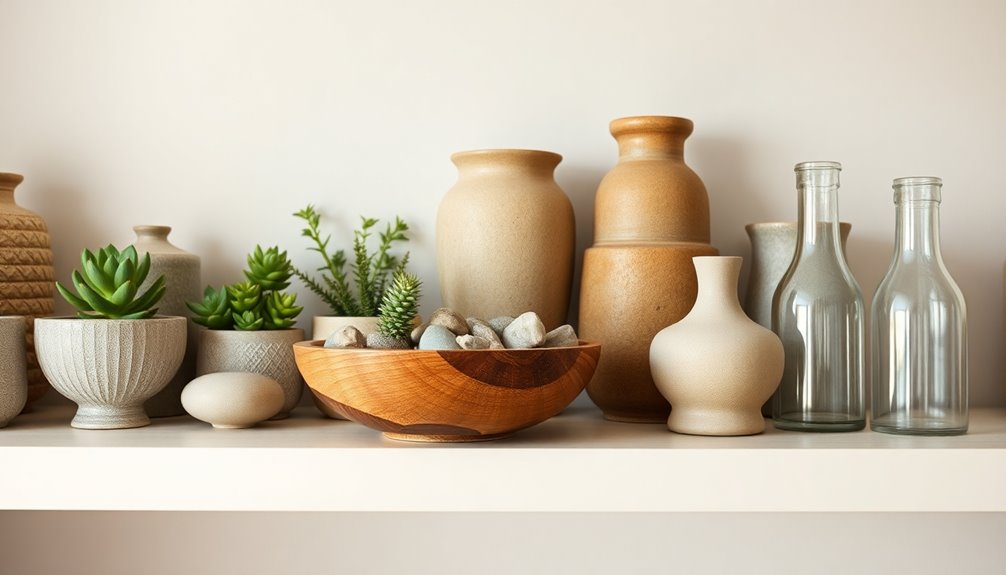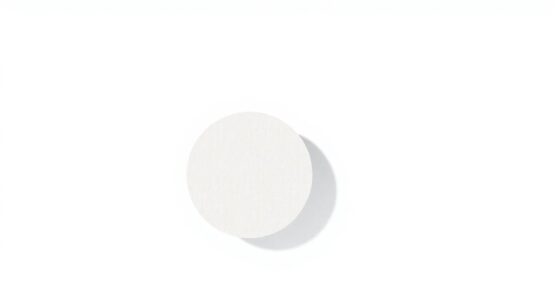Styling open shelves without clutter is all about balance and function. Start by organizing items by category and prioritizing frequently used pieces on lower shelves. Use decorative bins for storage and select multiples of the same item for a cohesive look. Incorporate plants and art to add personal flair while maintaining visual appeal. Regularly reassess your arrangement to prevent buildup. Discover more tips to elevate your open shelving game and make it a stunning focal point in your space.
Key Takeaways
- Prioritize accessibility by placing frequently used items on lower shelves, making them easy to reach and minimizing clutter.
- Use decorative boxes or bins to organize smaller items, enhancing visual appeal while keeping surfaces tidy.
- Regularly assess and rotate displayed items to maintain organization and prevent clutter buildup over time.
- Group similar items by function or theme for easy navigation and a cohesive look on your shelves.
- Embrace a minimalist approach by selecting a few standout pieces that reflect your style, reducing visual clutter.
Understanding the Benefits of Open Shelving
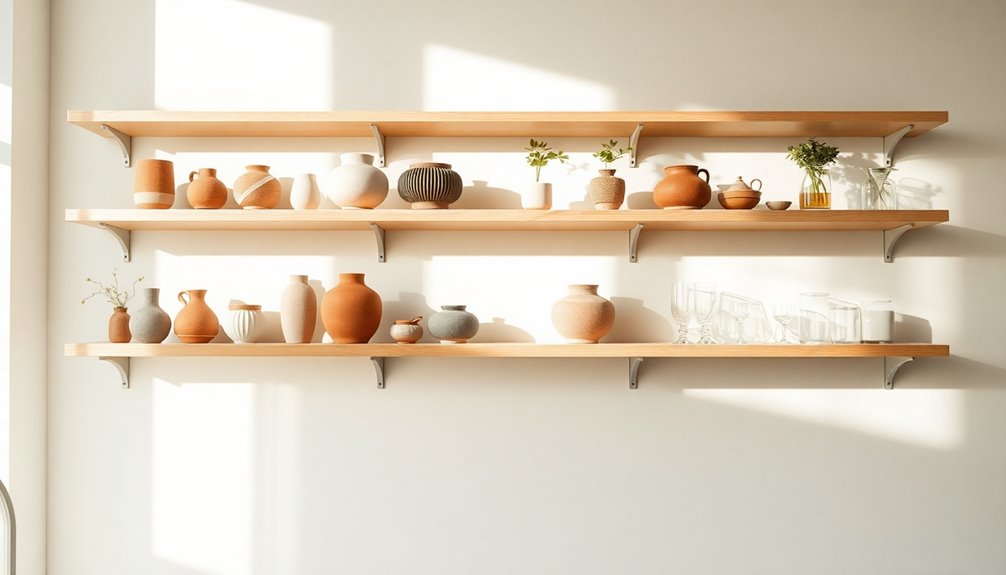
When you opt for open shelving in your kitchen, you gain easy access to your favorite items without the hassle of opening cabinet doors. This style not only makes daily use convenient but also adds character and dimension to your space.
By showcasing personal decor and dishware, open shelving enhances your kitchen's aesthetic appeal. You can express your unique taste by arranging items creatively, turning everyday essentials into artful displays.
Showcase your style with open shelving, transforming everyday dishware into stunning displays that enhance your kitchen's beauty.
Additionally, open shelving simplifies kitchen organization, allowing for a quick unloading process from the dishwasher directly onto the shelves.
Incorporating natural elements like plants can further elevate your home decor, adding life and texture that complements your overall design. Utilizing functional spaces in your kitchen layout can also enhance the overall flow and usability.
Embrace the benefits of open shelving and transform your kitchen into a stylish haven.
Essential Design Principles for Open Shelves
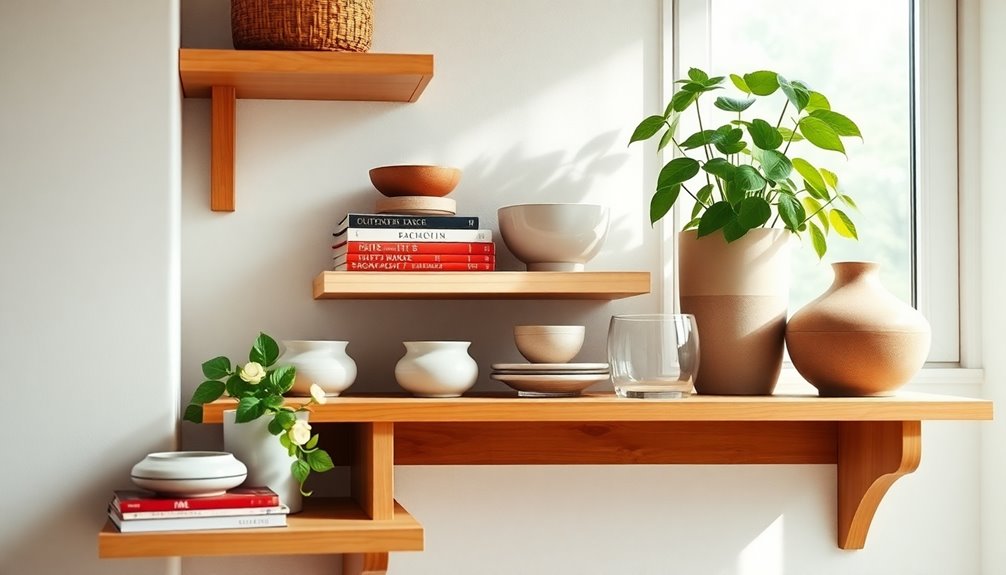
To create a visually appealing and functional open shelf display, you need to balance design principles with practicality. Start by ensuring you have space between shelves for taller items and regularly assess your arrangement to prevent clutter. Aim for a consistent number of items to promote balance, and use multiples of the same item for a unified look. Arrange items with their faces in the same direction to enhance visual appeal and symmetry. Surround your open shelves with complementary fixtures to create a cohesive design. Finally, incorporate practical elements like decorative boxes or fabric bins to keep your shelf styling both attractive and functional. Additionally, remember that assessing client needs is essential for creating a personalized and effective design that reflects individual style.
| Design Principle | Description | Example |
|---|---|---|
| Balance | Consistent number of items | Three vases |
| Visual Direction | Align faces in the same direction | Books and decor items |
| Practical Elements | Use decorative bins for organization | Fabric storage bins |
Tips for Achieving Cohesive Aesthetics
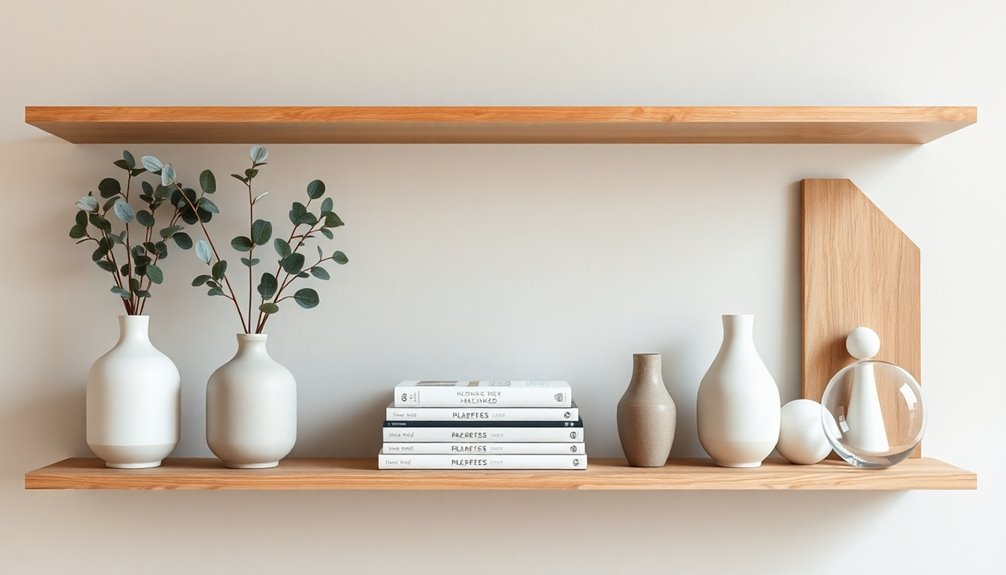
To achieve cohesive aesthetics on your open shelves, start by selecting multiples of the same item to create a unified look. Consider how visual absorption can help reduce clutter, making your display feel organized and functional. Don't forget to prioritize accessibility by placing frequently used items where you can easily reach them. Additionally, embracing intentional living can enhance the overall appeal of your space while aligning with your minimalist values.
Unified Item Selection
Creating a cohesive aesthetic on open shelves often starts with a unified item selection. Using multiples of the same item, like matching dishes or decorative boxes, creates a unified look that enhances visual coherence.
Choose items that share a similar color or style; this harmony makes your shelves more inviting.
Prioritize accessibility by placing frequently used items on lower shelves, ensuring practicality while maintaining that cohesive aesthetic. Reserve decorative items for higher shelves, which helps maintain order and allows functional items to shine.
Regularly assess and adjust your arrangement to keep the shelves visually appealing and free of clutter. This ongoing attention to your selections will help you achieve a beautifully styled space that reflects your personal taste. Additionally, consider using performance metrics to evaluate how well your arrangement works in practice and make necessary adjustments.
Visual Absorption Techniques
Achieving a cohesive aesthetic on open shelves relies on effective visual absorption techniques that draw the eye and create harmony.
Using multiples of the same item, like identical jars or plates, helps unify your display and reduces clutter. Incorporate matching items to establish a seamless flow, allowing the eye to move smoothly across the shelf.
Grouping items in clusters rather than spacing them evenly fosters a dynamic look, giving visual breathing room. Reserve decorative pieces for higher shelves while keeping functional items lower, which maintains order and enhances the overall appeal. Additionally, the use of soft color palettes can further enhance the visual harmony on your shelves, creating a serene atmosphere.
Accessibility and Usability
When styling open shelves, prioritizing accessibility and usability can transform your space into a functional yet aesthetically pleasing area. Place frequently used items on lower shelves to enhance accessibility, making daily tasks efficient. Aim for visual balance by keeping a consistent number of items across shelves, contributing to a cohesive look. Use a limited color scheme with matching dishware to avoid visual clutter and create harmony. Arrange items in clusters to draw the eye and maintain interest. Additionally, consider the importance of long-term financial planning as you invest in high-quality items that enhance both utility and beauty in your space.
| Item Type | Placement | Visual Balance |
|---|---|---|
| Dishware | Lower shelves | Consistent numbers |
| Decorative pieces | Upper shelves | Limited colors |
| Cookbooks | Mid-level shelves | Clustered layout |
Incorporating Functional Elements
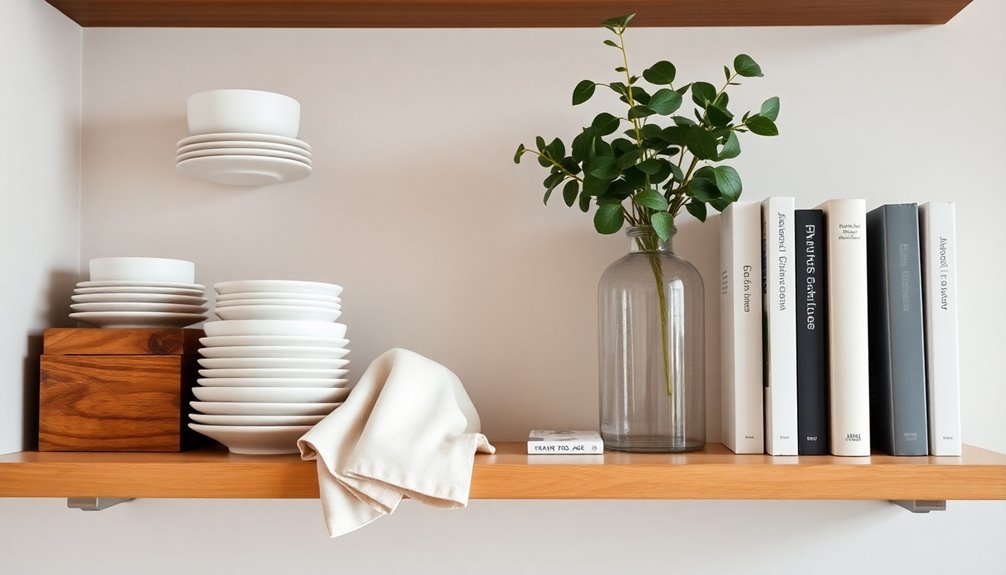
Incorporating functional elements into your open shelves not only enhances usability but also elevates your decor.
Prioritizing functionality means placing frequently used items on lower shelves for easy access. Utilize decorative boxes for storage or fabric bins to maintain organization while adding a stylish touch. Guarantee there's enough space between shelves to accommodate taller items, preventing overcrowding and improving usability.
Regularly assess the functionality of displayed items to avoid clutter and keep only what's necessary. Additionally, consider unique shelf shapes that not only bring character to your display but also offer practical solutions for organizing and showcasing your items effectively. Incorporating educational toys can also add a playful touch to your decor while promoting cognitive growth.
Maintenance and Cleaning Strategies
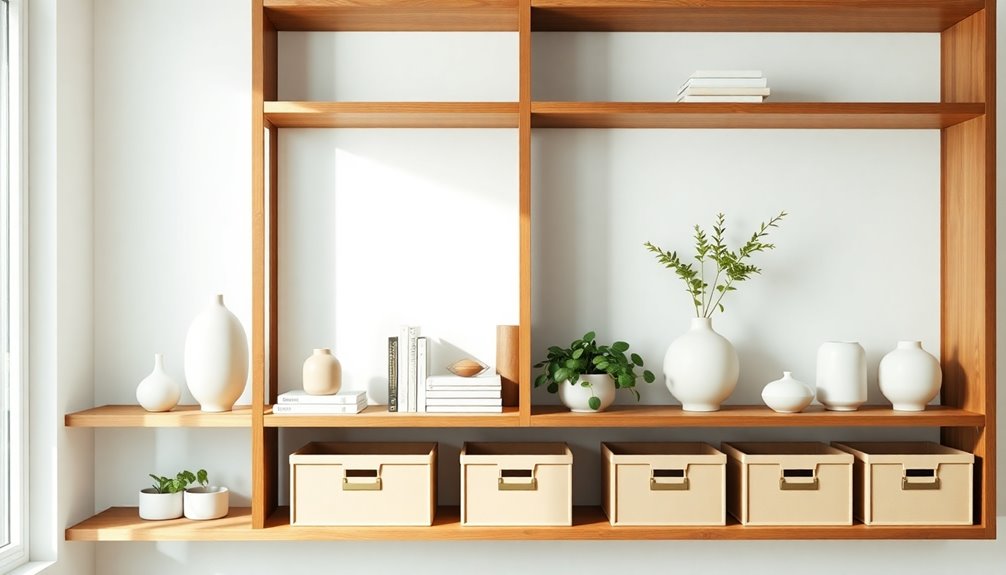
To keep your open shelves looking their best, establishing a consistent maintenance routine is essential.
Start with weekly dusting to prevent dust accumulation, and schedule a monthly deep cleaning session. Organize frequently used items on lower shelves, making them easy to access and clean regularly. This approach reduces dust buildup in hard-to-reach areas.
Incorporate decorative boxes or bins to group smaller items, simplifying your cleaning routine and minimizing clutter. Regularly assess the functionality of your displayed items; remove or relocate anything that's seldom used to maintain a tidy space.
If cleanliness is a concern, consider glass front cabinetry as an alternative, keeping your items dust-free while still showcasing them beautifully. Additionally, regularly assess the functionality of your displayed items to ensure they serve a purpose, which helps maintain a tidy space.
Personalizing Your Open Shelving Style

How can you make your open shelves truly yours? Start by personalizing your space with items that reflect your aesthetic, like rich wood tones, ceramics, and natural elements such as plants. These choices not only enhance visual appeal but also maintain functionality. Incorporate multiples of the same item, like matching dishes, to create a cohesive look that minimizes clutter. Decorative storage solutions, such as fabric bins and wicker baskets, add texture and warmth to your shelves while helping you stay organized. Group art pieces and personal finds, like your children's nature treasures, to infuse your shelves with personality. Regularly reassessing your arrangement guarantees your open shelving evolves with your style, keeping it fresh and inviting. Additionally, remember that innovative interior design ideas can inspire unique shelving arrangements that showcase your personal flair.
Practical Considerations for Your Space
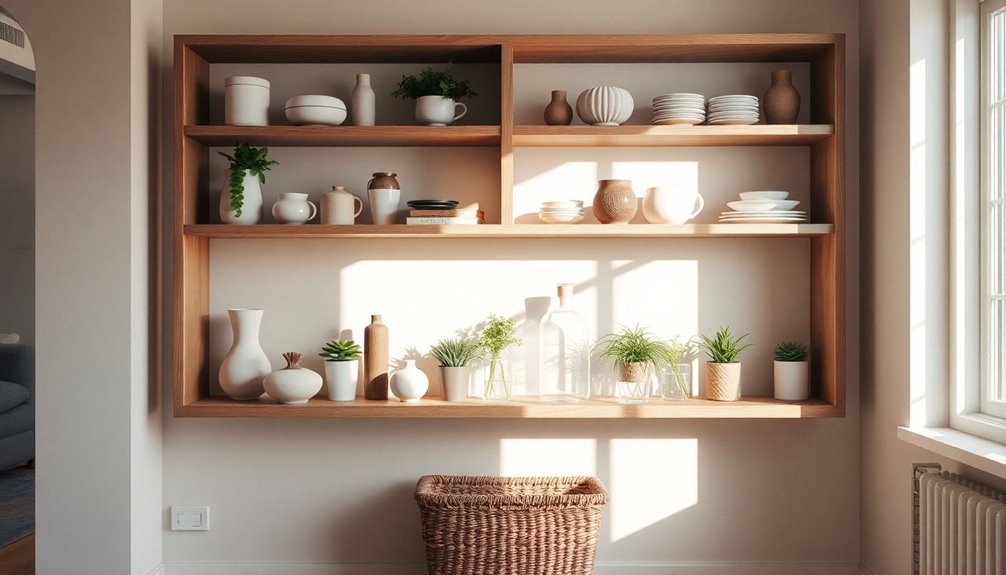
While open shelving can add charm and functionality to your space, it's essential to contemplate practicality before installation.
Start by evaluating your room's layout—ensure the open shelving complements your existing cabinetry and doesn't crowd the area. Aim for a balanced arrangement that provides breathing room; overcrowded shelves can quickly become cluttered.
Remember, practicality is key: choose items that you use frequently for easy access, while reserving a few decorative pieces to enhance visual appeal. Incorporating unique pieces can also create focal points and conversation starters in your open shelves.
Regularly rotate and restyle your displayed items to keep the shelves fresh and organized.
Frequently Asked Questions
How to Make Open Shelving Not Look Cluttered?
To make open shelving look less cluttered, limit the number of items on each shelf and group them in clusters.
Stick to a uniform color palette of 1-2 main colors to keep things cohesive.
Incorporate varying heights and shapes to add interest while maintaining balance.
Use decorative boxes or baskets for smaller items to reduce chaos.
Regularly assess and rotate your displayed items to keep your shelves fresh and functional, preventing dust and clutter buildup.
What Is the Rule of 3 for Shelves?
Imagine walking into a room where every shelf tells a story. The Rule of 3 helps you create that narrative.
By grouping items in threes, you draw the eye in a natural flow, making your display feel dynamic and balanced. Vary the heights and shapes of your items for added interest.
Focus on one standout piece with two complementary items, ensuring your shelves feel curated and engaging, not cluttered!
How to Make Open Shelving Look Tidy?
To make open shelving look tidy, start by limiting the number of items on each shelf to three to five.
Use decorative boxes or bins for smaller items, keeping everything organized.
Stick to a consistent color palette of one or two shades to create a cohesive look.
Regularly check your shelves, removing or rotating items as needed to avoid clutter.
Finally, balance the visual weight by placing larger items on lower shelves.
How Do You Decorate a Bookshelf Without It Looking Cluttered?
They say, "Less is more," and that's especially true when you're decorating a bookshelf.
Start by organizing your books by color or size for a clean look. Use decorative boxes to store smaller items, keeping things tidy.
Add some greenery to bring life to the shelves. Group items in clusters and vary their heights to create visual interest.
This way, your bookshelf will look stylish without feeling cluttered or overwhelming.
Conclusion
In the end, styling your open shelves can turn a cluttered space into an enchanting gallery of your personality. By blending functionality with aesthetics, you'll create a harmonious display that feels both inviting and organized. Remember, your shelves are like a canvas—each item tells a story. Embrace your creativity, keep it tidy, and let your unique style shine through. With these tips in hand, you're ready to transform your shelves into a work of art!
